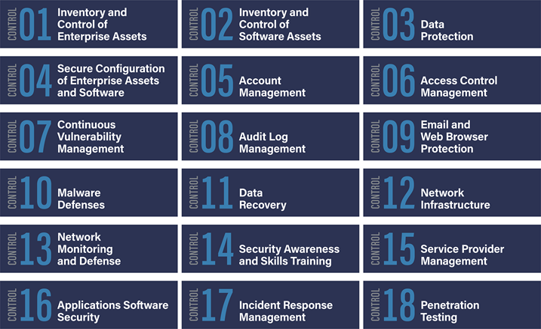Implementing the CIS Controls#
The CIS Critical Security Controls™ are a prioritized set of actions that collectively form a defense-in-depth set of best practices that mitigate the most common attacks against systems and networks. They are developed by a consensus-based community of cybersecurity experts and are globally accepted security best practices.
Within each of the 18 CIS Controls is a set of safeguards focused on a specific security function. There are a total of 153 safeguards. Experience has shown that organizations of every size and complexity need help to get started with the CIS Controls, and to focus their attention and resources.

The CIS Implementation Groups (IGs) were created to address this need. These IGs provide a simple and accessible way to help organizations of different classes focus their scarce security resources, and still leverage the value of the CIS Controls program, community, and complementary tools and working aids.
The CIS Controls are organized into IGs, each with its own unique list of Safeguards. The IGs are defined according to three attributes:
Data sensitivity and criticality of services offered by the organization
Expected level of technical expertise exhibited by staff or on contract
Resources and expertise available and dedicated toward cybersecurity activities
This results in three IGs, and the maturities in this Guide are loosely based on those IG classifications:
IG1: Basic. Contains controls that help an organization assess its current security and take simple steps to improve it. Roughly equivalent to the Level 1 maturity.
IG2: Foundational. Contains more advanced guidance to improve an organization’s security. Roughly equivalent to the Level 2 maturity.
IG3: Organizational. Contains controls that make changes to an organization’s policies to improve and maintain their cybersecurity. Roughly equivalent to the Level 3 maturity.
Goals#
Implement the appropriate IGs for your organization (Level 1 maturity)
Actions#
For Implementing the CIS Controls, the necessary actions vary by maturity as detailed below.
Level 1 Maturity#
Implement the IG1 controls.
The easiest way to do this is through the Level 1 Priorities. This will help you complete all of the actions for the Level 1 maturity, including IG1.
You can also use the CIS Controls Navigator to get to export a convenient list of the IG1 controls.
Level 2 Maturity#
Organizations operating at a Level 2 maturity should take additional actions, including:
Implement the IG2 controls. Use the CIS Controls Navigator to get this done.
Level 3 Maturity#
Organizations operating at a Level 3 maturity should take additional actions, including:
Implement all of the CIS Controls that are applicable for your environment. Use the CIS Controls Navigator to get this done.
Cost-Effective Tools#
CIS Controls Navigator: A simple tool to allow export of customized sets of safeguards from the CIS Controls.
CIS Controls version 8: A prioritized set of actions that collectively form a defense-in-depth set of best practices that mitigate the most common attacks against systems and networks.
Mapping to CIS Controls and Safeguards#
All!
Mapping to CIS Handbook Best Practices#
There are no relevant Handbook best practices